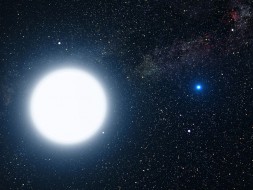
NASA / ESA / G. Bacon (STScI)
The brightest star in the sky is Sirius, also known as the “Dog Star” or, more officially, Alpha Canis Majoris, for its position in the constellation Canis Major. Sirius is a binary star dominated by a luminous main sequence star, Sirius A, with an apparent magnitude of -1.46. Sirius A’s apparent brightness can be attributed both to its inherent luminosity, 20 times that of the Sun, and its proximity. At just 8.7 light years away, Sirius is the seventh closest star to Earth.
In 1844, Friedrich Wilhelm Bessel suggested that the slightly wavy path of Sirius A through the sky, compared to that of background stars, indicated a fainter companion. Alvan Clark confirmed the companion’s existence in 1862. Now known to be a white dwarf and nicknamed the "Pup," Sirius B is easily spotted in a large telescope, but contributes little to the system’s total apparent brightness. Up for a real observing challenge? Read how you can spot Sirius B in "Sirius B — A New Pup in My Life," by contributing editor Bob King.
Given that other stars are closer to Earth than Sirius, why don't they appear brighter? Just as most grains of sand on a beach are small, the majority of stars in our galaxy — indeed, in the universe — are dwarfs: red dwarfs, to be exact. Along with their smaller size, they're correspondingly dim. In fact, the closest star to the Sun, Proxima Centauri, is a red dwarf. This M-class star is smaller and less luminous than our G-class Sun, and far smaller and less luminous than the brightest star, A-class Sirius. (The full sequence of stars is OBAFGKM, known by the famous "Oh Be A Fine Girl/Guy, Kiss Me!" acronym. Read more about how stars are classified here.)
Find Sirius with our Northern Hemisphere star wheel.
 0
0








Comments
You must be logged in to post a comment.